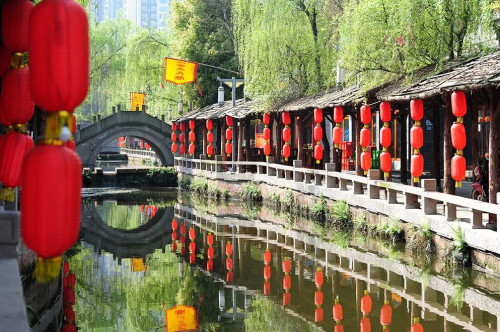Taste the longevity culture at the 24th Bridge of Changshou Bodhi Ancient Town
Creativity is an attitude, a focus, and a pursuit. The bricks and tiles of Changshou Bodhi Ancient Town, building and building, all demonstrate the ingenuity of artists, designers and builders.

Changshou Bodhi Ancient Town has two major water systems, one is Qinglong River and the other is Wanshou River. These two water systems are the main tourist routes except Wanshou Road. There are twenty-four bridges of different styles on the Qinglong River and Wanshou River.

In this way, the ancient town uses water as a carrier and bridges as a link to form a rare treasure land of feng shui.
"On the bright night of the twenty-fourth bridge, where can the jade man teach to play flute?" The 24th Bridge in Yangzhou written by Du Mu is a ridicule of old friends and a remembrance of Jiangnan. The 24th Bridge in Yangzhou carries the romantic fantasies of literati and poets.

The 24th Bridge in Changshou Bodhi Ancient Town is different from the 24th Bridge in Yangzhou. In addition to the bridge shape focusing on the combination of tradition and modernity, it also highlights the Chinese Fushou culture and Bayu local cultural characteristics in terms of cultural temperament, becoming a unique natural and cultural landscape.

The 24th Bridge in Changshou Bodhi Ancient Town is divided into four groups. The first group is the six Fushou bridges, which are Pengzu Bridge, Magu Bridge, Guishou Bridge, Yantao Bridge, Wuling Bridge and Qiao Weng Bridge. They are representatives of Chinese Fushou culture.

The second group is the six Bazu bridges, which are Wuxian Bridge, Shennong Bridge, Dayu Bridge, Yujun Bridge, Shennu Bridge and Jiangjun Bridge, revealing the early origin of the Bayu culture.
The third group is Yuyun Six Bridges, which are Liangjiang Bridge, Huaiqing Bridge, Kuimen Bridge, Zhuzhi Bridge, Bayao Bridge and Yulin Bridge, reflecting the natural and humanistic traditions of the Bayu area.
The fourth group is Changshou Six Bridges, which are Huanhou Bridge, Wenfeng Bridge, Donglin Bridge, Bodhi Bridge, Shenshou Bridge, and Huanzhu Bridge. They display the Changshou Huanhou Palace, Wenfeng Tower, Donglin Temple, Bodhi Mountain, Tiancishou Island, Huanzhu Tower and other natural and cultural attractions and famous cultural figures one by one.

Each of the twenty-four bridges in Changshou Bodhi Ancient Town has a connotative name, beautiful stories, and a sculpture that reflects these historical stories.
For example, the Yulin Bridge is taken from the story of Emperor Jianwen seeking refuge and longevity in the Yulin River; the Liangjiang Bridge is taken from the Chaotianmen Gate where the Yangtze River and the Jialing River converge; and the Bayao Bridge is taken from the high-pitched, heroic and powerful trumpets of the Chuanjiang River shouted out by the trackers carrying heavy loads.

Legend has it that in order to escape the pursuit of Zhu Di, the founder of the Ming Dynasty, Emperor Jianwen of the Ming Dynasty went to Linshui to seek refuge in Du Jingxian, an old minister of his grandfather Zhu Yuanzhang. According to records in "History of the Ming Dynasty: Benji" and "Annals of Linshui County", Emperor Jianwen twice took a boat to Linshui Yaotan, and his monarch and his subjects rowed in the deep gorges of the Taihong River, looked at the mountains and water, and read "Li Sao" in a sad and sad manner. Later generations recalled this incident and changed the name of Linshui to Yulin River.
In addition to Bayu culture, the bridge in the ancient town is also rich in blessing and longevity cultural connotations. Walking through the Pengzu Bridge, you will have eight hundred years of life, and you will live forever; walking through the Magu Bridge, you will see the East China Sea turning into mulberry fields three times; walking through the Yantao Bridge, you will send lotus fragrance for ten miles, and everyone wishes longevity; walking through the Guishou Bridge, turtles and cranes will last forever, thousands of them...

Visiting these exquisite stone bridges is like walking through China's Stone Bridge Museum and reading a profound historical book on China's Fushou Culture and Bayu Culture.
Previous Article:When fireworks fall under Yangzhou in March, don't forget to visit Zhuyan Bay, where the Yijiang River controls the Huaihe River
